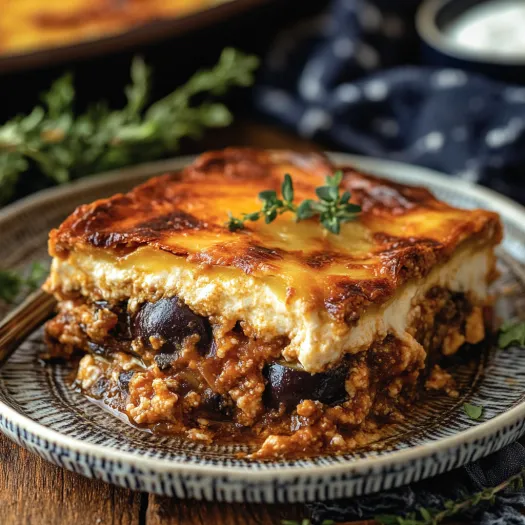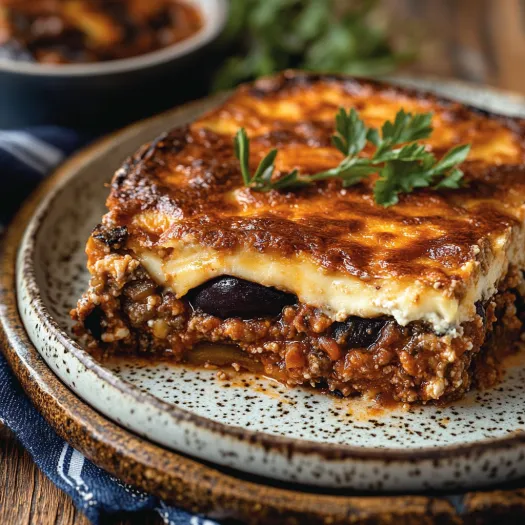 Save
Save
This hearty Greek Moussaka turns simple ingredients into an amazing Mediterranean comfort dish. The stacked casserole blends soft eggplant, potatoes, and flavorful meat sauce topped with a velvety béchamel that gets golden and bubbly while baking. It's just right for family gatherings or when you want to wow friends with real Greek tastes.
I cooked this moussaka for my partner's parents who'd been all over Greece, and they said it was as good as what they ate during their travels. It's now what we make whenever we want Mediterranean flavors without needing a passport.
Ingredients
- Eggplants: Go for shiny, hard ones without mushy parts to get the right bite and taste
- Yellow potatoes: They stay firm when you fry and bake them
- Olive oil: Pick a nice extra virgin type for the meat mix to boost those Mediterranean notes
- Red onions: They're a bit sweeter than yellow ones in the meat filling
- Garlic: Nothing beats fresh cloves for adding deep flavor to the meat sauce
- Ground beef: 80/20 gives the best taste, but you can use leaner if you want
- Cinnamon: This key spice brings that real Greek feel to your dish
- Tomato paste: Packs a punch that makes the meat sauce richer
- Chopped tomatoes: Adds wetness and tang to balance the hearty meat
- Dry red wine: Cleans the pan bottom and makes the meat sauce more interesting
- Butter: The starting point for any good béchamel sauce
- Flour: Makes the base that thickens your béchamel just right
- Whole milk: Gives you the smoothest béchamel, don't swap for low-fat kinds
- Nutmeg: A must-have béchamel spice that works well with the cinnamon in the meat
- Parmesan cheese: Brings a savory boost to the béchamel layer
- Egg yolks: Makes the béchamel richer and helps it firm up during baking
Step-by-Step Instructions
- Prepare the Eggplant:
- Cut eggplants into 3/8-inch rounds, add salt to both sides, and set in a colander. Let them sit for 30 minutes to drain extra moisture, which stops the dish from getting mushy. Don't skip this step if you want perfect texture.
- Create the Meat Filling:
- Warm olive oil in a deep pan over medium-high heat. Cook red onions until clear, around 5 minutes, then throw in garlic and cook 2 more minutes until you can smell it. Mix in ground beef, sugar, salt, and cinnamon, breaking up the meat as it browns. The sugar cuts the acid while cinnamon brings that special Greek flavor.
- Develop the Sauce:
- Add tomato paste and cook for a minute to get rid of the raw taste and boost the flavor. Pour in chopped tomatoes and wine, scraping up all those tasty brown bits from the bottom. Add the bay leaf, turn heat to low, and let it bubble uncovered for 30 minutes until thick and the flavors mix well. Take out the bay leaf when done.
- Make the Béchamel:
- Heat butter in a big pan over medium heat. Mix in flour and cook this mix for 2 minutes on low until it smells a bit nutty but isn't brown. Slowly add room temp milk with salt, pepper, and nutmeg. Stir often until the sauce gets thick enough to stick to a spoon. Take off the heat, mix in 1/2 cup of Parmesan, cool for 5 minutes, then stir in egg yolks until smooth and shiny.
- Prepare the Eggplant and Potatoes:
- Dry the salted eggplant with paper towels. You can fry them in olive oil until golden on both sides or bake at 425°F for 15 minutes, flipping once. For potatoes, slice them 3/8-inch thick and fry or bake until golden. Put both on paper towels to soak up extra oil.
- Assemble the Moussaka:
- Heat oven to 350°F and grease a 9x13 inch baking dish. First layer the bottom with potato slices that overlap. Next add half the eggplant slices. Spread the meat sauce evenly on top. Add the rest of the eggplant slices over the meat, slightly overlapping. Pour the béchamel over everything and sprinkle with the other 1/4 cup of Parmesan cheese.
- Bake to Perfection:
- Bake uncovered for an hour until the top turns golden brown and the edges bubble. This slow baking lets all the flavors mix while the béchamel sets into a creamy top. Let it rest for at least 15 minutes before cutting so the layers can set and the flavors settle.

The cinnamon in this moussaka really takes me to Greece every time I cook it. My Greek friend next door taught me this dish, saying that this tiny bit of spice is what makes real moussaka different from any old casserole. Guests always ask about that warm flavor they can't quite figure out.
The Art of Salting Eggplant
Putting salt on eggplant before cooking does two helpful things. It pulls out water, which keeps your moussaka from getting soggy. It also takes away any bitter taste, especially in bigger, older eggplants. After they sit for 30 minutes, make sure to dry the eggplant really well before cooking. If you're rushed and have young, fresh eggplants, you might skip this step, but your dish won't turn out quite as good.
Make-Ahead Options
You can easily make moussaka ahead of time. Put the whole dish together up to 24 hours before baking and store it in the fridge. Just cook it about 15 minutes longer if it's cold from the fridge. You can also freeze the assembled but uncooked moussaka for up to 3 months. Thaw it completely in the fridge before baking. You can even make all the parts separately up to 2 days ahead and put them together right before baking.
Serving Suggestions
Greeks usually serve moussaka warm instead of hot, so the flavors can settle and the layers firm up. Serve it with a basic Greek salad made with cucumber, tomato, red onion, kalamata olives, and feta cheese with olive oil and lemon juice. Grab some crusty bread to soak up all the yummy sauces. For wine, try a medium-bodied red like Agiorgitiko from Greece or a Syrah that goes well with the cinnamon in the meat sauce.

Try this fantastic moussaka to bring the real taste of Greece into your home without booking a flight.
Common Recipe Questions
- → How early can I prepare Greek Moussaka?
It's easy to prepare this ahead! Assemble everything and refrigerate unbaked for up to 24 hours. Alternatively, prepare parts separately—meat sauce, topped veggies, and béchamel—and put them together just before baking. Fully baked leftovers can also be stored; reheat at 350°F when ready to serve.
- → What can replace eggplant in this dish?
If eggplant isn't your thing, try zucchini, squash, or thin sweet potato slices. Each adds a unique flavor but keeps the layered balance. Some recipes even replace eggplant with extra potatoes. Just make sure your swap is pre-cooked to avoid watery layers.
- → Is it okay to freeze Greek Moussaka?
Yes, freezing works brilliantly! For the unbaked version, assemble and freeze tightly wrapped for up to three months. When baking from frozen, let it thaw overnight in the fridge. Cooked leftovers also store well—wrap them up and reheat straight from the freezer at 350°F until warm.
- → Why should I salt eggplant before cooking?
Salting eggplant does wonders. It reduces bitterness, takes out water that might make it soggy, and helps control oil absorption when frying. Older or bigger eggplants usually need this step most. After salting for around 30 minutes, rinse and dry them well to prep for cooking.
- → What pairs well with this dish?
With its richness, this pairs best with lighter sides. Favorites include a fresh Greek salad with cucumbers, tomatoes, and feta, warm pita bread, creamy tzatziki, or lightly steamed broccoli. For a bigger feast, add stuffed grape leaves and a nice glass of dry red wine.
- → How do I make it vegetarian?
It's easy to go vegetarian! Swap out the meat for lentils, crumbled plant-based substitutes, or a sautéed mix of mushrooms and walnuts. Stick with the same seasonings for that Greek flavor. The layering and creamy béchamel remain the same.
